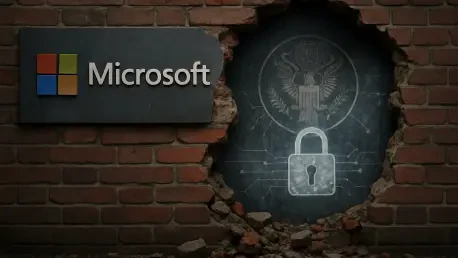In a world where digital systems form the backbone of critical sectors like healthcare, education, and government, the persistent cybersecurity shortcomings of a tech giant like Microsoft have become a pressing concern for national stability, exposing vulnerabilities that could jeopardize public safety. Repeated breaches, outdated security measures, and a seeming disregard for robust design have exposed millions of sensitive records and disrupted essential services across the United States. These incidents are not just corporate missteps; they strike at the core of public safety, leaving vital infrastructure vulnerable to exploitation by malicious actors. The scale of Microsoft’s influence in enterprise IT magnifies every flaw, turning individual lapses into systemic risks that could undermine trust in the digital ecosystem. As cybercriminals grow bolder, the urgency to address these failures has never been greater, prompting sharp criticism from political leaders and security experts alike. This issue demands a closer look at how such a dominant player’s negligence ripples through society, threatening the very foundations of security.
Systemic Failures and Their Consequences
Exposing Vulnerabilities Through Design Flaws
The root of Microsoft’s cybersecurity challenges often lies in design choices that favor ease of use over stringent protection, a decision that has led to catastrophic breaches in critical sectors. A glaring example is the Ascension Health incident, where nearly six million patient records were compromised after a contractor inadvertently clicked a malicious link on Bing. This breach was made possible by Microsoft’s continued reliance on the outdated RC4 encryption protocol, long deemed insecure but kept as a default setting for compatibility with legacy systems. Such prioritization of convenience over safety has left hospitals, schools, and public agencies exposed to relentless cyber threats. The incident is not an isolated one but part of a troubling trend where inadequate security measures fail to protect sensitive data, allowing attackers easy access to systems that millions depend on for essential services, thereby eroding confidence in digital infrastructure.
Beyond specific cases, Microsoft’s pattern of negligence reveals a deeper systemic issue in how security is approached within the tech giant’s software development processes. The persistence of insecure defaults, coupled with slow responses to known vulnerabilities, creates an environment ripe for exploitation by sophisticated cybercriminals. Hospitals and other critical institutions, already stretched thin, bear the brunt of these failures as they scramble to mitigate damage after breaches occur. Reports indicate that many of these organizations lack the resources to implement robust countermeasures independently, making them reliant on vendors like Microsoft to prioritize security from the ground up. When such trust is betrayed through preventable lapses, the consequences extend far beyond data loss, impacting patient care, educational continuity, and governmental operations, and highlighting the urgent need for a fundamental shift in how software security is engineered.
Ripple Effects on Critical Infrastructure
Microsoft’s pervasive role in enterprise IT means that a single flaw in its systems can destabilize entire networks, posing a direct threat to national infrastructure and defense. The 2023 Storm-0558 attack, orchestrated by Chinese state actors exploiting weaknesses in Exchange Online, demonstrated how such vulnerabilities can be weaponized to access sensitive communications. Similarly, a 2024 SharePoint flaw enabled persistent network intrusions, allowing attackers to maintain long-term access to compromised systems. These incidents illustrate how Microsoft’s security lapses serve as entry points for adversaries targeting not just private companies but also government entities reliant on these platforms. The cascading effect of such breaches can disrupt everything from defense operations to public utilities, amplifying the stakes of each failure in an interconnected digital landscape.
The dominance of Microsoft in the IT ecosystem further compounds these risks, as its software underpins the majority of business and governmental operations worldwide. When vulnerabilities are exploited, the fallout is not contained within a single organization but spreads across sectors, creating widespread chaos. National security experts have repeatedly warned that state-sponsored hackers and criminal syndicates view Microsoft’s platforms as high-value targets due to their ubiquity. Each successful attack undermines the integrity of critical systems, potentially exposing classified information or halting essential services. The reality is stark: as long as Microsoft remains the backbone of enterprise technology, its security shortcomings will continue to pose an outsized threat to the stability and safety of national infrastructure, necessitating immediate and comprehensive action.
Political and Public Backlash
Demanding Oversight and Accountability
Growing frustration with Microsoft’s track record has spilled into the political sphere, where influential figures are calling for stringent measures to address the tech giant’s role in cybersecurity crises. Democratic Senator Ron Wyden has been particularly vocal, accusing Microsoft of “gross negligence” and likening the company to an “arsonist selling firefighting services.” This sharp analogy reflects the paradox of a corporation that contributes to security problems while marketing solutions through its cloud and cybersecurity offerings. Wyden’s push for a Federal Trade Commission (FTC) investigation underscores a broader sentiment that insecure software should be treated as a public safety hazard, comparable to defective products in other industries. Such political pressure signals a pivotal moment where tech giants may face unprecedented scrutiny for their impact on national well-being.
The call for regulatory action is not merely rhetorical but rooted in a desire to enforce accountability through tangible consequences. Treating insecure defaults and outdated protocols as unfair business practices could set a precedent for how software vendors are held responsible for the risks they create. Senator Wyden’s advocacy highlights a critical shift in perspective, viewing cybersecurity not just as a technical issue but as a matter of public policy that demands federal intervention. The frustration is palpable among lawmakers who see repeated breaches as evidence of systemic failure, especially when the same vendor profits from both the problem and the remedy. This mounting pressure from political leaders could reshape the landscape of tech regulation, forcing companies to prioritize security over market-driven conveniences in their product designs.
Public Trust Under Siege
Public sentiment mirrors political outrage, as trust in Microsoft’s ability to safeguard critical data continues to erode with each high-profile breach. Communities affected by incidents like the Ascension Health compromise express growing unease over how personal information is handled by such a dominant tech provider. When healthcare records, educational data, and government files are exposed, the fallout affects real lives, from delayed medical treatments to compromised privacy. This erosion of confidence extends beyond individual users to organizations that rely on Microsoft’s infrastructure, many of whom now question whether their dependence on a single vendor places them at unacceptable risk. The public’s demand for reliability and transparency is becoming louder, pushing for answers on why preventable failures persist.
Moreover, the narrative of Microsoft as a trusted partner is increasingly challenged by independent reports and cybersecurity analyses that point to recurring patterns of neglect. Bodies like the Cyber Safety Review Board have issued scathing assessments of the company’s practices, further fueling public skepticism. As awareness of these issues grows, there is a palpable shift in how society views the role of tech giants in protecting digital spaces. The expectation is no longer just innovation but also accountability, with citizens and advocacy groups pressing for assurances that their data will not be the next casualty of corporate oversight. This groundswell of concern could drive momentum for broader reforms, compelling both industry and government to rethink how trust is built and maintained in an era of constant digital threats.
Broader Cybersecurity Challenges
Emerging Dangers in a Connected World
The cybersecurity landscape is evolving at an alarming rate, with new threats exposing the inherent fragility of interconnected digital systems beyond just Microsoft’s sphere. Supply chain attacks, such as the Shai-Hulud worm targeting npm packages, reveal how a single compromised component can infiltrate vast networks, undermining trust in software dependencies. Similarly, the Toneshell remote access Trojan, engineered for stealth and persistence, demonstrates the sophistication of modern malware designed to evade detection. These emerging dangers highlight a critical truth: in a world where systems are deeply linked, a weak link anywhere can trigger widespread disruption. The complexity of defending against such threats requires a vigilance that current practices often fail to meet, leaving organizations exposed to relentless and innovative adversaries.
Adding to this precarious environment is the risk of endpoint failures, as evidenced by the 2024 CrowdStrike Falcon sensor update debacle that disrupted over eight million Windows machines globally. This incident underscored how even routine updates, intended to enhance security, can become catastrophic points of failure when not meticulously managed. Industries ranging from finance to transportation ground to a halt, revealing the domino effect of relying on centralized systems for endpoint protection. The scale of such disruptions serves as a wake-up call, emphasizing that the cybersecurity challenges of today are not isolated to specific vendors but are systemic, woven into the fabric of digital reliance. Addressing these risks demands a reevaluation of how updates and dependencies are handled to prevent single errors from cascading into global crises.
Reliance on a Questionable Foundation
The U.S. government’s continued dependence on Microsoft for critical IT infrastructure raises profound concerns about the risks of entrusting national interests to a vendor with a history of security lapses. Despite numerous breaches and public critiques, federal agencies remain heavily tied to Microsoft’s platforms, often citing a lack of viable alternatives or the complexity of transitioning to other systems. This dependency amplifies the potential impact of any vulnerability, as government operations—from defense to public services—rely on the integrity of these tools. The question looms large: how can national security be assured when the foundational technology is repeatedly proven to be a weak point in the face of determined cyber adversaries?
Compounding this issue is the absence of a diversified approach to IT procurement within governmental structures, which limits resilience against vendor-specific failures. Cybersecurity experts argue that over-reliance on a single provider creates a monoculture in digital systems, where one flaw can compromise an entire network of agencies. The critiques from bodies like the Cyber Safety Review Board only heighten the urgency to explore alternative solutions or enforce stricter security mandates on existing contracts. Without such measures, the government risks perpetuating a cycle of vulnerability, where each breach serves as a reminder of misplaced trust. The path forward must involve strategic diversification and rigorous oversight to ensure that national interests are not held hostage by the shortcomings of any one technology provider.
Path Forward for Cybersecurity
Building a Proactive Security Framework
Addressing the crisis of cybersecurity failures requires a fundamental shift toward proactive, rather than reactive, strategies that prioritize protection from the outset. Enterprises and governments alike must advocate for secure-by-default systems, where robust security settings are the standard rather than an optional feature. This means moving away from outdated protocols and ensuring that compatibility does not trump safety in software design. Additionally, third-party audits should become a norm, providing independent validation of security measures to catch vulnerabilities before they are exploited. Such steps would force a reevaluation of current practices, pushing vendors to embed resilience into every layer of their products and reducing the likelihood of breaches that endanger critical sectors.
Layered defenses also play a crucial role in this new framework, with technologies like endpoint detection and response (EDR) and zero trust architectures offering a multi-faceted approach to safeguarding systems. Zero trust, in particular, operates on the principle of verifying every access request, regardless of origin, effectively minimizing the risk of lateral movement by attackers within a network. Meanwhile, EDR systems provide real-time monitoring and response capabilities, crucial for detecting and mitigating threats as they emerge. Adopting these measures requires investment and a cultural shift within organizations to view security as an integral part of operations, not a costly add-on. By embracing such comprehensive strategies, the digital ecosystem can better withstand the evolving tactics of cybercriminals, ensuring that critical infrastructure remains protected against both current and future threats.
Lessons Learned for Future Resilience
Reflecting on the string of cybersecurity incidents tied to Microsoft, it becomes evident that past oversights have left deep scars on public trust and national safety. Each breach, from Ascension Health to Storm-0558, serves as a harsh reminder of what is at stake when security takes a backseat to convenience. The political outcry, led by figures like Senator Ron Wyden, has pushed the conversation into the public domain, forcing a reckoning with how tech giants are held accountable. Regulatory bodies like the FTC have begun to scrutinize practices once overlooked, setting a precedent for treating software vulnerabilities as public safety issues. These developments mark a turning point, where the failures of yesterday inform the policies of tomorrow, aiming to prevent similar crises.
Looking ahead, the focus must shift to actionable solutions that build resilience into the digital landscape. Encouraging collaboration between industry, government, and independent auditors could foster the development of standards that prioritize secure design over legacy compatibility. Investing in research for alternative IT solutions might reduce dependency on single vendors, creating a more robust ecosystem. Furthermore, educating organizations on the importance of layered defenses and proactive measures could empower them to mitigate risks independently. These steps, grounded in the lessons of past breaches, offer a blueprint for a future where cybersecurity is not just a reaction to threats but a foundational pillar of technological advancement, ensuring that national security is never again compromised by preventable failures.









